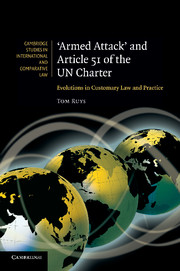Book contents
- Frontmatter
- Contents
- Acknowledgment
- Table of abbreviations and abbreviated citations
- Selected case law, legislation and related documents
- Introduction
- 1 The methodological debate and the quest for custom
- 2 ‘Armed attack’ and other conditions of self-defence
- 3 The ‘armed attack’ requirement ratione materiae
- 4 The ‘armed attack’ requirement ratione temporis
- 5 The ‘armed attack’ requirement ratione personae
- 6 What future for the ‘armed attack’ criterion?
- Index
- References
5 - The ‘armed attack’ requirement ratione personae
Published online by Cambridge University Press: 10 January 2011
- Frontmatter
- Contents
- Acknowledgment
- Table of abbreviations and abbreviated citations
- Selected case law, legislation and related documents
- Introduction
- 1 The methodological debate and the quest for custom
- 2 ‘Armed attack’ and other conditions of self-defence
- 3 The ‘armed attack’ requirement ratione materiae
- 4 The ‘armed attack’ requirement ratione temporis
- 5 The ‘armed attack’ requirement ratione personae
- 6 What future for the ‘armed attack’ criterion?
- Index
- References
Summary
The final aspect of the ‘armed attack’ requirement is at the same time the most complex one: from whom must an armed attack emanate in order to trigger the right of self-defence? Clearly, attacks by States' regular forces come within the purview of Article 51 UN Charter. In extenso, it is accepted that non-recognized de facto regimes can mount ‘armed attacks’. But are cross-border actions also warranted if a certain nexus exists between armed bands carrying out attacks and the State from whose territory they operate? And what about situations where there is no clear link between the two or where a State is simply unable to prevent a non-State actor from launching the attacks?
The present chapter is divided in two sections, reflecting the different Zeitgeist governing the first four decades of the Charter era and more recent years. As for the former period (Section 5.1), the debate on ‘indirect military aggression’ was strongly influenced by the struggle for decolonization, in particular by the question whether States could extend armed support to national liberation movements. Throughout the 1980s, this issue – which was never authoritatively settled – has gradually become moot. Instead, today, the growing support for a flexible reading of the ratione personae aspect is by and large inspired by the increasingly prominent threat of international terrorism, manifested by deadly attacks on innocent civilians in New York, London, Madrid, Mumbai, Istanbul, Casablanca, Bali and elsewhere (Section 5.2).
- Type
- Chapter
- Information
- 'Armed Attack' and Article 51 of the UN CharterEvolutions in Customary Law and Practice, pp. 368 - 510Publisher: Cambridge University PressPrint publication year: 2010

